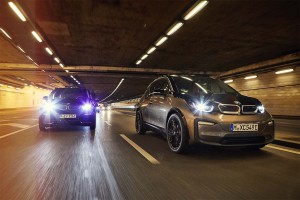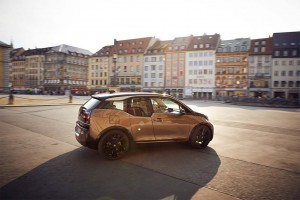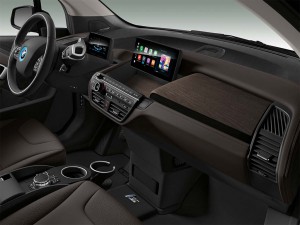
BMW is looking to eliminate the criticism about the range, or lack thereof, on its i3 city car with a bump to 153 miles.
BMW’s little city car, the i3, has won plenty of kudos since it was first launched in the 2014 model-year, but it has also turned off a number of potential buyers who simply can’t get charged up about its limited range.
That may change in the coming months, BMW today announcing a new, extended-range model, the i3 120Ah, as well as the sportier i3s 120Ah, The two versions will deliver a nearly 30% increase in range compared to the current, all-electric i3. BMW also plans to offer the new battery pack with the i3 REX, the city car variant that adds a gas-powered range-extending engine, though final EPA numbers have not yet been released.
Even with the more capable battery pack the i3s 120Ah might best be described as a longer-range version of the quirky BMW electric vehicle, now offering 153 miles between charges, compared to 115 miles with the largest battery pack it previously offered. That roughly matches what you’ll get with the second-generation Nissan Leaf, but falls well short of the 238 miles offered by the Chevrolet Bolt EV and the nearly 300 miles delivered by the Tesla Model 3 with its optional extended-range battery pack.
And, as for the numbers, don’t get confused, the 120Ah designation refers to battery capacity measured in amp-hours. That’s out of sync with the specs most manufacturers use. The Chevy Bolt, for example, offers 60 kilowatt-hours of energy. Falling in line with everyone else, the new BMW i3 120Ah translates into a capacity of 42.2 kilowatt-hours, or kWh.
(BMW’s iNext offers a glimpse at automaker’s autonomous, electrified future. Click Here for the story.)
Nonetheless, that’s a big improvement. The original i3 featured a modest 60Ah, or about 21 kilowatt-hour lithium-ion battery pack. That increased to 94Ah for the 2017 model-year.
Early on, automakers routinely argued that with the average U.S. motorist clocking well under 80 miles a day, vehicles like the original i3 would more than satisfy most needs. In reality, BMW executives acknowledged during a recent preview of the prototype iNext battery-electric vehicle, most drivers purchase vehicles based on what they think they might need at the extremes.
(Click Here to seem about BMW making all M models electric by 2030.)
Studies have backed that up, showing the vast majority of shoppers – even those focused on the environment – won’t buy electric unless range increases to 150, and even 200 miles. That appears to be backed up by demand for the Tesla Model 3. Whether BMW has hit the sweet spot will be tested in the coming months.
Beyond range, most of the specs for the i3 equipped with the new high-voltage pack remain the same for 2019. The “base” i3 uses a single rear axle-mounted electric motor to produce 170 horsepower and 184 pound-feet of torque. The sportier i3s 120Ah will continue to be rated at 181 hp and 199 lb-ft. The i3 will hit 60 in 7.2 seconds, the i3s cutting that to 6.8 seconds.
As before, the i3 siblings will rely on the heavy use of lightweight carbon fiber to maximize range and performance. There will be virtually no changes to the exterior or interior, however, short of a new exterior paint color and a new shade for the optional Mega World upholstery. Full LED headlights with cornering capability and auto-dimming high beams will be added as options.
(For more on BMW’s plans to up EV and AV spending, Click Here.)
The navi system is slightly upgraded, and the 2019 city car adds a WiFi hotspot and wireless charging to the option list.


